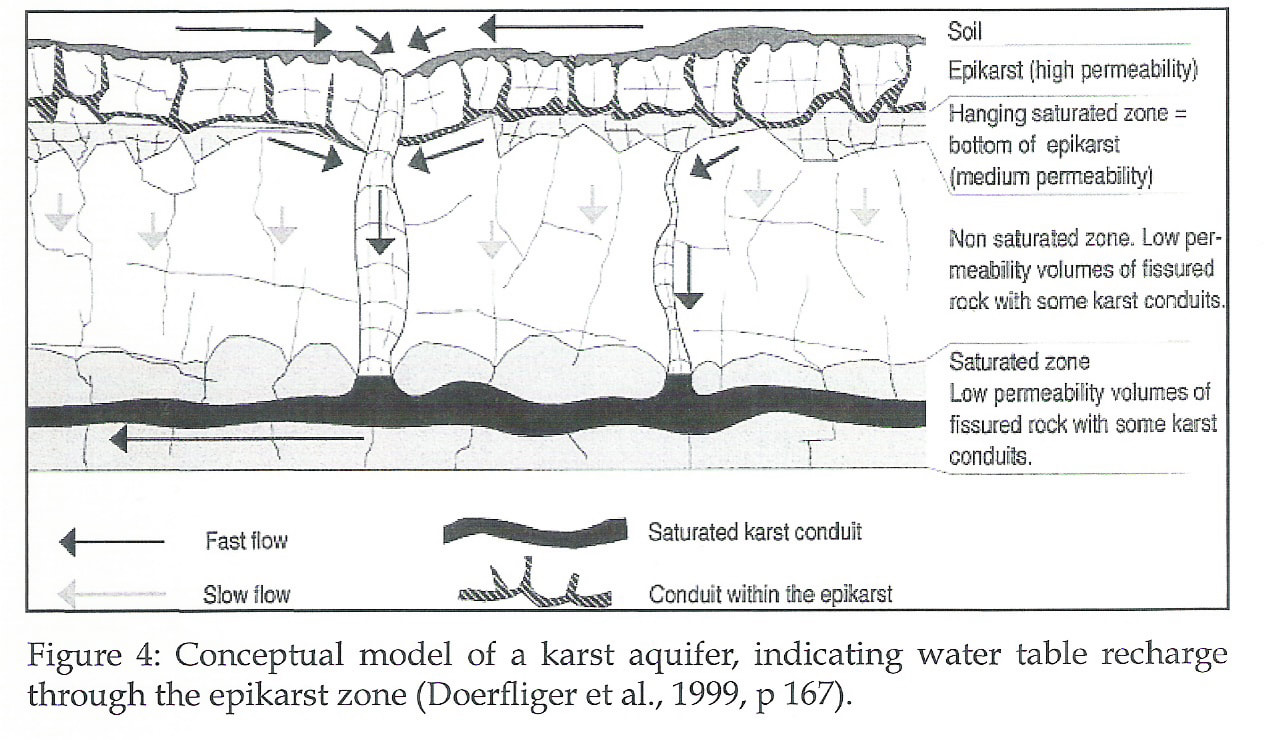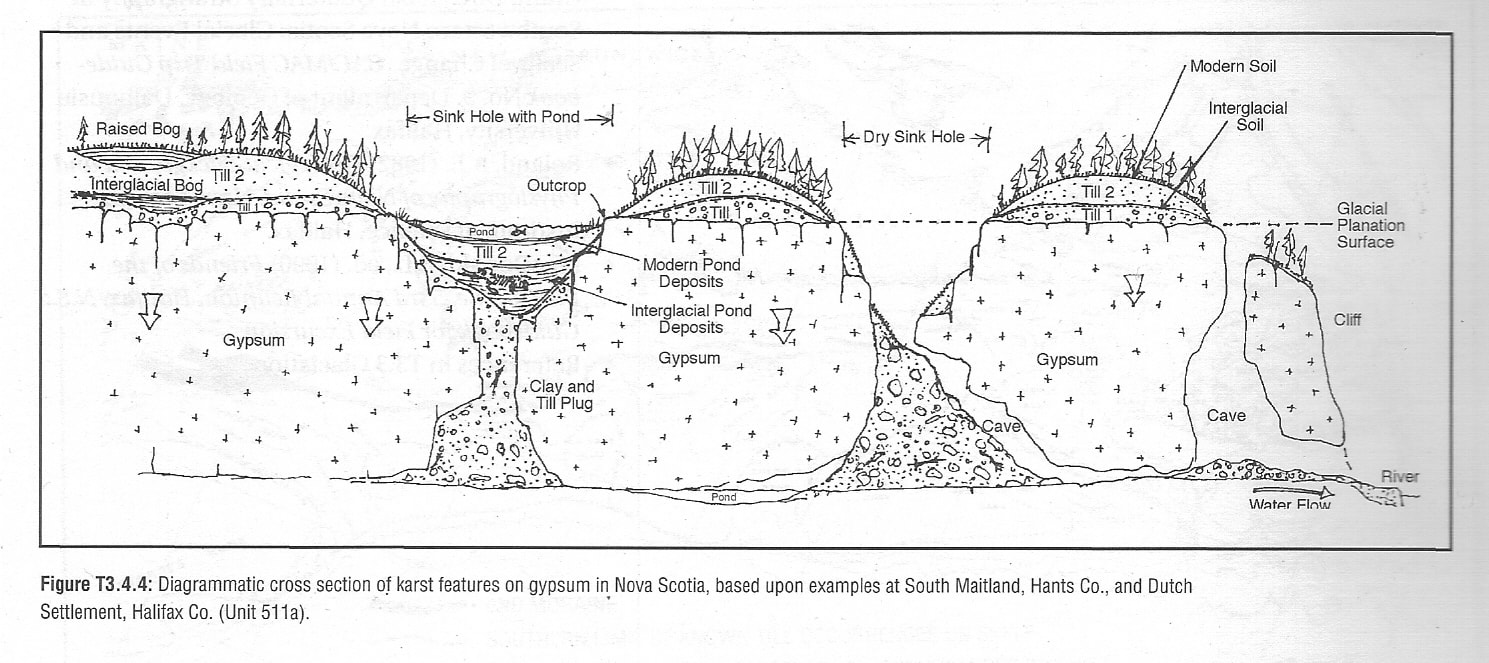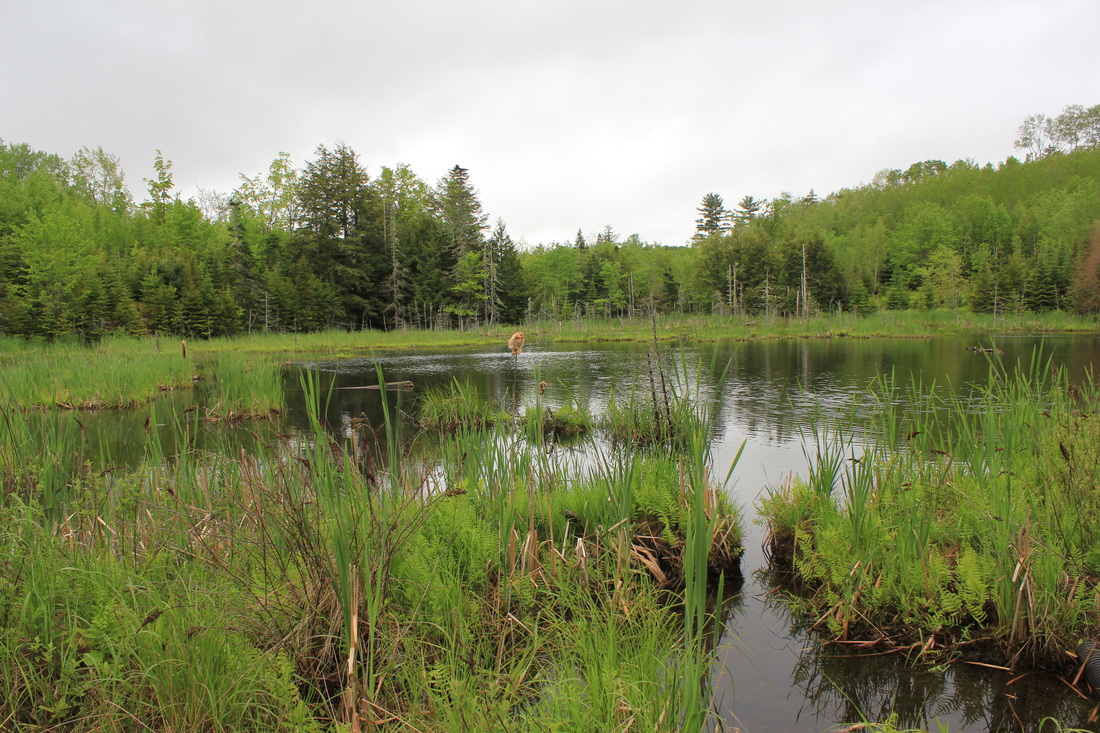The Karst Environment of the Avon Peninsula
The Avon Peninsula features a unique Karst environment, which is a distinctive topography in which the landscape is largely shaped by the dissolving action of water on carbonate bedrock like limestone, dolomite, or gypsum.
This geological process, which occurs over many thousands of years, results in unusual surface and subsurface features ranging from sinkholes, vertical shafts, disappearing streams, and springs, to complex underground drainage systems and caves.
As rain falls through the atmosphere, it picks up CO2 which dissolves in the droplets. Once the rain hits the ground, it percolates through the soil, picking up more CO2 to form a weak solution of carbonic acid: H2O+CO2=H2CO3. The infiltrating water naturally exploits any cracks or crevices in the rock. Over long periods, with a continuous supply of CO2 - enriched water, carbonate bedrock begins to dissolve. Openings in the bedrock increase in size and an underground drainage system begins to develop, allowing more water to pass, further accelerating the formation of Karst. Eventually this leads to the development of subsurface caves.
This geological process, which occurs over many thousands of years, results in unusual surface and subsurface features ranging from sinkholes, vertical shafts, disappearing streams, and springs, to complex underground drainage systems and caves.
As rain falls through the atmosphere, it picks up CO2 which dissolves in the droplets. Once the rain hits the ground, it percolates through the soil, picking up more CO2 to form a weak solution of carbonic acid: H2O+CO2=H2CO3. The infiltrating water naturally exploits any cracks or crevices in the rock. Over long periods, with a continuous supply of CO2 - enriched water, carbonate bedrock begins to dissolve. Openings in the bedrock increase in size and an underground drainage system begins to develop, allowing more water to pass, further accelerating the formation of Karst. Eventually this leads to the development of subsurface caves.
Karst landscapes comprise an important component of the Earth’s geodiversity. Karst and its dependent ecosystems are sensitive and vulnerable to an array of human impacts, and require careful management. Caves frequently contain features that are fragile, like speleothems, sediments, and bones, as well as biota that are very sensitive to disturbance from human activities.
Located in the heart of the Avon Peninsula is the Wiscoq Valley. Wisqoq Cave, which means Black Ash in the native tongue of the Mi’kmaq people, is located in an area of mature Acadian forest dominated by Eastern Hemlock, White Ash and White Birch. Within the valley is the Wisqoq Cave, a natural dissolution cave formed in Mississippian age gypsum-anhydrite evaporites. In the immediate vicinity of the cave outcropping gypsum bedrock has eroded into an extremely rugged Karst terrain: referred to locally as “plaster land”.
Located in the heart of the Avon Peninsula is the Wiscoq Valley. Wisqoq Cave, which means Black Ash in the native tongue of the Mi’kmaq people, is located in an area of mature Acadian forest dominated by Eastern Hemlock, White Ash and White Birch. Within the valley is the Wisqoq Cave, a natural dissolution cave formed in Mississippian age gypsum-anhydrite evaporites. In the immediate vicinity of the cave outcropping gypsum bedrock has eroded into an extremely rugged Karst terrain: referred to locally as “plaster land”.

La péninsule Avon propose un environnement karstique unique, qui est une topographie particulière dont le paysage est en grande partie façonnée par l'action dissolvante de l'eau sur la roche carbonate comme le calcaire, la dolomie, ou de gypse.
Ce processus géologique, qui se produit sur plusieurs milliers d'années, les résultats de surface inhabituelle et les caractéristiques du sous-sol allant de dolines, puits verticaux, des ruisseaux qui disparaissent, et des sources, à des systèmes complexes et des grottes de drainage souterrain.
Que la pluie tombe à travers l'atmosphère, il capte le CO2 qui se dissout dans les gouttelettes. Une fois que la pluie frappe le sol, il percole à travers le sol, ramasser plus de CO2 pour former une solution faible d'acide carbonique: H2O + CO2 = H2CO3. L'eau infiltrant exploite naturellement des fissures ou des crevasses dans la roche. Sur de longues périodes, avec un apport continu de CO2 - l'eau enrichie, substratum carbonate commence à se dissoudre. Les ouvertures dans l'augmentation du substratum rocheux de taille et d'un système de drainage souterrain commence à se développer, ce qui permet plus de passer l'eau, accélérant encore la formation de Karst. Finalement, ce qui conduit au développement de grottes souterraines.
Les paysages karstiques comprennent une composante importante de la géodiversité de la Terre. Karst et ses écosystèmes dépendants sont sensibles et vulnérables à un tableau des impacts humains, et nécessitent une gestion attentive. Caves contiennent souvent des caractéristiques qui sont fragiles, comme concrétions, des sédiments et des os, ainsi que le biote qui sont très sensibles aux perturbations des activités humaines.
Situé au cœur de la péninsule Avon est la vallée de Wiscoq. Wisqoq Cave, ce qui signifie Black Ash dans la langue maternelle du peuple Mi'kmaq, est situé dans une zone de forêt acadienne matures dominés par la pruche du Canada, le frêne blanc et le bouleau blanc. Dans la vallée est le Wisqoq Cave, une grotte de dissolution naturelle formée en âge Mississippien évaporites de gypse anhydrite. Dans le voisinage immédiat de la grotte affleurement de gypse a érodé le substratum rocheux dans un terrain karstique extrêmement robuste: appelée localement «terre de plâtre".
Que la pluie tombe à travers l'atmosphère, il capte le CO2 qui se dissout dans les gouttelettes. Une fois que la pluie frappe le sol, il percole à travers le sol, ramasser plus de CO2 pour former une solution faible d'acide carbonique: H2O + CO2 = H2CO3. L'eau infiltrant exploite naturellement des fissures ou des crevasses dans la roche. Sur de longues périodes, avec un apport continu de CO2 - l'eau enrichie, substratum carbonate commence à se dissoudre. Les ouvertures dans l'augmentation du substratum rocheux de taille et d'un système de drainage souterrain commence à se développer, ce qui permet plus de passer l'eau, accélérant encore la formation de Karst. Finalement, ce qui conduit au développement de grottes souterraines.
Les paysages karstiques comprennent une composante importante de la géodiversité de la Terre. Karst et ses écosystèmes dépendants sont sensibles et vulnérables à un tableau des impacts humains, et nécessitent une gestion attentive. Caves contiennent souvent des caractéristiques qui sont fragiles, comme concrétions, des sédiments et des os, ainsi que le biote qui sont très sensibles aux perturbations des activités humaines.
Situé au cœur de la péninsule Avon est la vallée de Wiscoq. Wisqoq Cave, ce qui signifie Black Ash dans la langue maternelle du peuple Mi'kmaq, est situé dans une zone de forêt acadienne matures dominés par la pruche du Canada, le frêne blanc et le bouleau blanc. Dans la vallée est le Wisqoq Cave, une grotte de dissolution naturelle formée en âge Mississippien évaporites de gypse anhydrite. Dans le voisinage immédiat de la grotte affleurement de gypse a érodé le substratum rocheux dans un terrain karstique extrêmement robuste: appelée localement «terre de plâtre".


